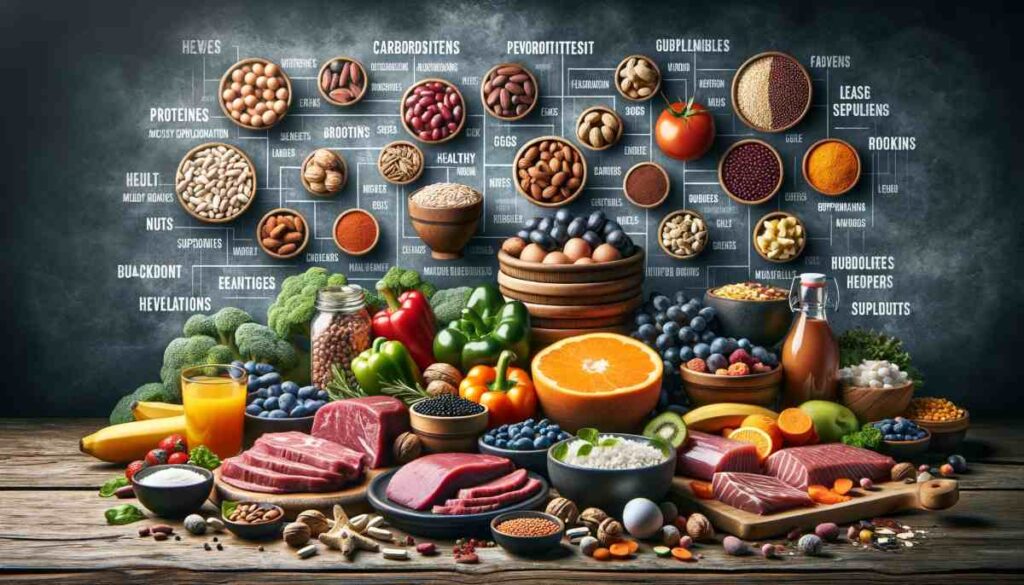I wanted to build muscle and get fitter. However, as someone new to working out and nutrition, I was overwhelmed by all the conflicting fitness advice online. That’s when I came across the Wellhealth program’s science-based and holistic muscle-building approach.
I will walk you through the key aspects of the Wellhealth How to Build Muscle Tag program, including:
- Fitness: How to train properly to stimulate muscle growth
- Nutrition: What and when to eat for optimal muscle building
- Recovery: The importance of rest for muscle growth
- Mindset: Developing the right mentality for success
- Goal Setting: How to set and track realistic goals
- Overcoming Plateaus: Strategies to get over training plateaus
I will also share practical tips, sample routines, and actionable insights based on the latest scientific research and our experience with the Wellhealth muscle-building system.
Whether you are a complete beginner or a seasoned gym-goer, this guide will provide a blueprint to build muscle effectively and sustainably.
Let’s start by understanding what muscle growth entails on a physiological level before into the specifics of the Wellhealth training methodology.
What is Muscle Growth?

Muscle growth refers to the enlargement of muscle fibers in response to exercise, particularly resistance or strength training. But what exactly happens inside our muscles when we lift weights?
Science of Muscle Protein Synthesis
The growth of skeletal muscle tissue relies on muscle protein synthesis (MPS). In essence, MPS stimulates the development of new muscle fibers to increase the size and strength of our muscles over time.
When we perform resistance exercises, such as squats, deadlifts, or bicep curls, we create small tears in the muscle tissue on a microscopic level. The body recognizes these microtears as damage and activates satellite cells to repair and reinforce the muscles.
- Satellite cells are muscle stem cells that play a crucial role in the adaptation and regeneration of muscles when we exercise.
As part of the healing and growth process, the satellite cells fuse with existing muscle fibers and donate their nuclei. These additional nuclei allow each fiber to produce more protein and expand in size.
- This increase in muscle fiber size owing to protein-induced nuclear expansion is called muscle hypertrophy. Over time, hypertrophy leads to overall muscle growth.
The rate at which our body can synthesize new muscle proteins ultimately determines how quickly our muscles grow. By training properly, eating right, and resting sufficiently, we can maximize muscle protein synthesis rates.
Types of Hypertrophy
There are two main types of hypertrophy:
- Sarcoplasmic hypertrophy refers to the growth of sarcoplasm, the non-contractile fluid within a muscle fiber. Increasing sarcoplasmic fluid leads to larger muscle volume and supports muscular endurance. Bodybuilders typically aim for substantial sarcoplasmic hypertrophy.
- Myofibrillar hypertrophy refers to the growth of myofibrils, which are chains of sarcomeres—the functional units within a muscle fiber composed of actin and myosin filaments. More myofibrils allow a muscle to contract with greater force, supporting gains in strength and some expansion of muscle fibers.
Powerlifters and other strength athletes predominantly train for myofibrillar hypertrophy while fostering some sarcoplasmic hypertrophy.
The Wellhealth program focuses on developing all muscle subcomponents for maximum functional fitness and aesthetics. Their training methodology stimulates optimal activation and hypertrophy of all muscle fibers.
How to Train for Maximum Muscle Growth

The exercise programming methodology of the Wellhealth system revolves around principles of progressive overload, specificity, variation, and vitality for incredible muscle-building outcomes:
Progressive Overload
Progressive overload means consistently increasing resistance or volume over time to challenge your muscles continually. The more overload we apply through training, the greater the stimulus for muscular and strength gains.
- As your body adapts to a given training stress, you must gradually do more—lift heavier loads, complete more reps or sets, reduce rest between sets, etc. This drives further physiological adaptation.
- Effective application of progressive overload ensures you never hit a plateau—your muscles always feel adequately challenged, keeping growth and progress coming over months and years of training.
Specificity
The specific muscles exercised through a given movement are placed under strain to prompt adaptation. This means choosing exercises that target your desired muscle growth goals.
- Isolation lifts involve motion predominantly around one joint to better isolate and fatigue specific muscles. For example, bicep curls heavily work the biceps brachii while limiting the involvement of other muscles.
- Compound lifts incorporate multiple joints and stimulate several muscle groups at once. For example, squats engage the quads, glutes, hamstrings, core, and other areas for more holistic, functional development.
Alter compound and isolation lifts as required to tailor hypertrophy outcomes to your needs and preferences.
Variation
Varying your routine continually exposes muscles to new stresses, keeping them actively developing across training cycles:
- Rotate between higher (6-12) and lower (12-20) rep ranges
- Occasionally use intensifiers like drop sets, supersets, tri-sets, etc.
- Modify rest intervals between sets
- Swap out some old exercises for new ones
- Change up set totals and order/sequence
- Play with training frequency and split focus
Adding thoughtful variation prevents accommodation, so you continue experiencing muscle and strength gains.
Vitality
Vitality means exercising with optimal health and vigor for amplified training capacity:
- Support workout vitality by fueling sufficiently before (eating carbs) and hydrating during training
- Use focused breathing to maintain muscular energy and stamina
- Focus mentally on correct form and mind-muscle connection
- Appropriately manage program variables like volume for sustainable progress
Remaining vibrant keeps you training productively. Progress happens from session to session, not just between phases. Vitality transports your baseline fitness ceiling higher over time.
Sample Wellhealth Muscle Building Routine

Below is a full-body workout routine applying the Wellhealth training principles for tremendous muscular development:
Workout A
| Exercise | Sets | Reps | Rest |
|---|---|---|---|
| Barbell Back Squat | 4 | 6-8 | 90s |
| Bench Press | 4 | 6-8 | 90s |
| Barbell Bent Over Row | 3 | 8-10 | 60s |
| Overhead Shoulder Press | 3 | 8-10 | 60s |
| Incline Dumbbell Bicep Curl | 3 | 10-12 | 45s |
| Lying Triceps Extensions | 3 | 10-12 | 45s |
| Calf Raises | 2 | 15-20 | 30s |
Workout B
| Exercise | Sets | Reps | Rest |
|---|---|---|---|
| Deadlifts | 4 | 6-8 | 90s |
| Incline Bench Press | 4 | 6-8 | 90s |
| Lat Pulldowns | 3 | 8-10 | 60s |
| Seated Shoulder Press | 3 | 8-10 | 60s |
| Preacher Curls | 3 | 10-12 | 45s |
| Overhead Triceps Extensions | 3 | 10-12 | 45s |
| Leg Press | 2 | 15-20 | 30s |
- Perform Workouts A and B once weekly, leaving at least 72 hours between sessions for recovery.
- Over time, progress load, sets, reps, etc., per overload principles.
- Occasionally deload for a week to promote continued progress.
- Mix up variables regularly, adding variation.
- Maintain focus, hydration, rest intervals, etc., for optimal vitality.
This program checks all the boxes— overload, specificity, variation, vitality—for incredible muscle-building potential. Feel free to substitute comparable exercises as desired over time.
Let’s now focus on diet, which forms the nutritional foundation necessary to reap the rewards of your muscle-building efforts in the gym.
Nutrition Guidelines for Muscle Growth

Exercise stimulates muscular development; nutrition supplies the required raw materials. With proper diet support, your fitness endeavors may bear fruit.
Here are key diet and supplementation guidelines to fuel exceptional muscle gains:
Calorie Surplus
To synthesize muscle proteins and expand fiber size from training, you must consume adequate calories to meet heightened energy demands:
- A moderate caloric surplus facilitates muscle growth by providing energy for cellular processes driving hypertrophy.
- Calculate your maintenance calories, then increase daily intake by 300-500 calories to promote muscle protein synthesis rates.
- Gain weight steadily week-to-week, not excessively. Excess calories disproportionately increase body fat, which blunts muscle definition.
Protein Intake
Muscle tissue comprises an abundant protein. Consuming adequate protein supplies amino acid building blocks to manufacture new muscle:
- Protein also spikes muscle protein synthesis rates more than other macronutrients.
- Time protein intake pre and post-workout to nourish muscles.
- Lean meats, dairy, eggs, etc., offer high-quality complete proteins.
Carbohydrates
Muscle glycogen provides the predominant energy substrate for fueling high-intensity resistance training:
- Ensure carbohydrate availability for workout performance by targeting 3-5 grams per pound of body weight daily.
- Around workouts, increase intake of complex starches, providing a steady glycogen supply like rice, potatoes, and oats.
- Whole food choices boast additional nutrients; some supplements, like dextrose, rapidly replenish glycogen.
Fat
Fat supports various biological functions like hormone production, making adequate intake necessary:
- Shoot for 0.4-0.5 grams of mostly unsaturated fats per pound of body weight daily.
- Whole food sources like fatty fish, avocado, nuts, seeds, and oils like olive and coconut contribute essential fats.
- Additional calories from fat help those struggling to eat enough daily calories consistently.
Pre/Post Workout Nutrition
Strategically timed protein and carbohydrate nutrition before and after sessions primes the body for heightened muscle protein metabolism:
- Pre-workout nutrition provides fuel for strenuous strength training while limiting muscle breakdown. Consume some protein and carbohydrates about 60-90 minutes prior.
- Post-workout nutrition seeks to initiate muscle repair and growth processes rapidly. Quickly consume protein and carbs following training.
- Whey, nut butter, soda, rice, banana, and other easily digested sources.
Supplements
Certain supplements complement whole food intake for enhanced muscular outcomes:
- Creatine boosts cellular energy, increasing training capacity and muscle mass gains from workout efforts.
- Beta-alanine raises muscle carnosine levels, improving intra-set endurance for more overload stimulus.
- Other solid options include citrulline, caffeine, betaine, protein powder, etc., under the guidance of a fitness professional.
Now that we understand how to fuel muscles for growth through exercise and nutrition, let’s explore the pivotal role rest plays in repairing muscle damage and powering physiological adaptation.
Rest and Recovery for Muscle Growth

Rest allows trained muscles to consolidate the strength and physiological adaptations from workout sessions. Insufficient recovery impedes muscular development over time.
Sleep
Sound sleep constitutes the most critical recovery activity for muscle hypertrophy and body composition improvements:
- Muscle protein synthesis predominantly occurs during sleep more than waking hours.
- Sleep optimizes biological processes regulating metabolism, immunity, hormones, cognition, and other functions integral to fitness.
- Target 7-9 hours nightly. Prioritize consistency and quality of sleep through good sleep hygiene habits.
Rest Days
Programmed rest days enable muscles to regenerate between intense training sessions fully:
- Muscles broken down through strength training require extended recovery periods to rejuvenate fully. This supports progressive overload.
- Take 1-2 rest days between working the same major muscle groups to avoid overtraining.
- Some active recovery, like light cardio, stretching, etc., aids restoration without excessively fatiguing muscles.
De-load Periods
Occasional planned reductions in training intensity strategically facilitate greater fitness gains:
- After 12+ weeks of consistent progressive overload, take a de-load week, lifting around 30% less weight before ramping intensity up again.
- This allows cumulative fatigue to dissipate and adaptation to consolidating so you continue improving long-term.
- Deloads temporarily increase hunger and capacity for muscle growth upon reestablishing overload.
Nutrient Timing
Timed protein/carb intake before and after workouts optimizes muscular recovery:
- Pre/post-workout nutrition helps counteract muscular damage from training while heightening the adaptive response.
- Appropriately nourishing your body around sessions provides the raw material to regenerate muscle tissue stronger than before.
By sufficiently resting muscles between progressive overload stimuli, you set the stage for sustained, remarkable hypertrophy rewards over months and years of smart training.
Adopting an Optimal Mindset and Goal Setting for Muscle-Building Success

Beyond physical endeavors, cultivating the right mental approach and structured goal setting facilitates outstanding muscle-building results with the Wellhealth system.
Growth Mindset
Adopting a growth-oriented mindset creates a mental environment conducive to continued progress:
- View setbacks like plateaus as opportunities to tweak training/nutrition and break new ground afterward. Relish the challenge!
- Remain patient and trust your process for building muscle. Fatigue is necessary before adaptation.
- Stay focused day-to-day on incremental fitness gains using the Wellhealth principles for big-picture success.
SMART Goal Setting
Tangible, specific markers of progress keep you on track through SMART goal setting:
| SMART Component | Significance |
|---|---|
| Specific (S) | Ensures that the goal is detailed and not vague, providing clarity on what needs to be achieved. |
| Measurable (M) | Provides metrics to track progress, allowing for quantifiable assessment of goal attainment. |
| Achievable (A) | Sets realistic yet challenging objectives, pushing limits while ensuring feasibility. |
| Relevant (R) | Aligns with overall objectives and goals, ensuring that the target is pertinent to the broader context. |
| Time-bound (T) | Specifies a deadline or timeframe by which the goal should be achieved, adding urgency and accountability. |
- Set outcome-based goals like gaining 15 pounds of muscle by the end of the year.
- Define actionable process goals like lifting weights 4 times per week.
- Record goals someplace visible, like apps or vision boards.
Mind-Muscle Connection
Mentally targeting and contracting muscles during training heightens activation:
- Visualize muscles lengthening and shortening through conscious movement.
- Feel the targeted muscles working by focusing mentally on sensation.
- Maximizing mental stimulation trains muscles more completely.
You multiply possible progress by directing your mental faculties wholly on muscle building.
Tracking Progress to Drive Future Success
Closely monitoring muscle-building efforts furnishes insights into enhancing subsequent training cycles. Quantifying key performance metrics frequently reveals precise personal capabilities informing tangible goal setting.
Here are crucial markers providing feedback on muscle growth:
- Weight on the scale (gain around 0.25-0.5 pounds per week)
- Body fat percentage via scan (trending down)
- Measurements like chest, arms, thighs (increasing)
- Pictures documenting visual changes
- Workout logs like volume lifted (progressive overload)
- Nutrition tracking apps (sufficient calories/protein)
Analyze trends after 4, 8, or 12-week blocks, highlighting what is working well and any potential areas for bolstering progress. Review alongside your lifting partner or coach for greater objectivity.
This information-driven iterative approach fuels consistent muscle-building advancements for months and years as your fitness journey unfolds.
Strategies for Overcoming Training Plateaus
After an initial “newbie gains” period, muscle-building plateaus eventually hit even seasoned lifters as progress levels off. Plateaus transform into exciting PR breakthroughs by troubleshooting and strategically changing select training variables!
Here are techniques for rebooting muscle growth after stagnation:
Progressive Overload
- Increase intensity via heavier weights/lower reps
- Boost volume through additional sets
- Accelerate tempo slowing eccentric/explosive concentric
- Reduce rest intervals demanding greater work capacity
Exercise Selection
- Swap new lifts targeting muscles from fresh angles
- Shift stabilizer demands with free weights vs. machines
- Emphasize time under tension with intensifiers
Workout Organization
- Flip set sequencing altering mechanical and metabolic stresses
- Play with lifting frequency, hitting muscles more often weekly
- Transition split focus expanding weekly workload capacity
Nutrition
- Add Calories cycled over 12+ week mesocycle
- Time carbs training for fuel and protein for recovery
- Stack pre-workout supplements boosting performance
Reignite stagnant muscle growth, inserting thoughtful program design changes!
By effectively applying training, nutrition, and recovery principles from the Wellhealth system outlined here, you now have the tools needed to build noticeable amounts of muscle and strength relatively quickly.
Supplemental Tips for Maximizing Muscle Growth
Here is some additional guidance for enacting the core Wellhealth training methodology:
Diet
- Time daily calories and macronutrients per your schedule and preferences
- Clean bulking minimizes unnecessary fat storage from caloric surplus
- Experiment with carb timing around workouts, finding what works best
- Consume diverse protein sources for a complete amino acid profile
Technique
- Control lifting tempo, especially on eccentric, to amplify time under tension
- Target each major head and point of origination/insertion when flexing
- Establish mind-muscle connection via visualization and sensation focus
- Use lifting straps and belts during heavy sets as required
Recovery
- Light cardio promotes blood flow, aiding muscle recovery
- Foam roll regularly to alleviate muscle tightness and soreness
- Schedule occasional deload weeks for structured recovery
Progress Tracking
- Vary metrics quantified like body part girth, vertical jump, etc.
- Use apps to record training performance over time easily
- Take monthly progress photos in consistent poses, lighting, attire
- Get body composition testing illuminating muscle gain versus fat
Motivation
- Train with a reliable workout partner holds you accountable
- Make the program enjoyable with music and camaraderie
- Celebrate PRs and milestones, keeping momentum and building muscle
- Find social support like forums discussing goals and tribulations
Final Thoughts
I sincerely hope this guide into the Wellhealth training methodology gives you enhanced confidence and clarity in translating science into remarkable muscle-building success.
If maximal muscle gains are your objective, commit fully to their strength programming principles and carefully curate diet and rest habits. Monitor progress continually and experiment systematically.
Trust in the process and understanding plateaus and adversity will come. Persist through informed, strategic tweaking of variables.
Most importantly, stay consistent over months and years. Building appreciable muscle requires diligent lifestyle commitment, not ephemeral fad programs over mere weeks.
You absolutely can and will sculpt an outstanding physique. Now grab those gains!


